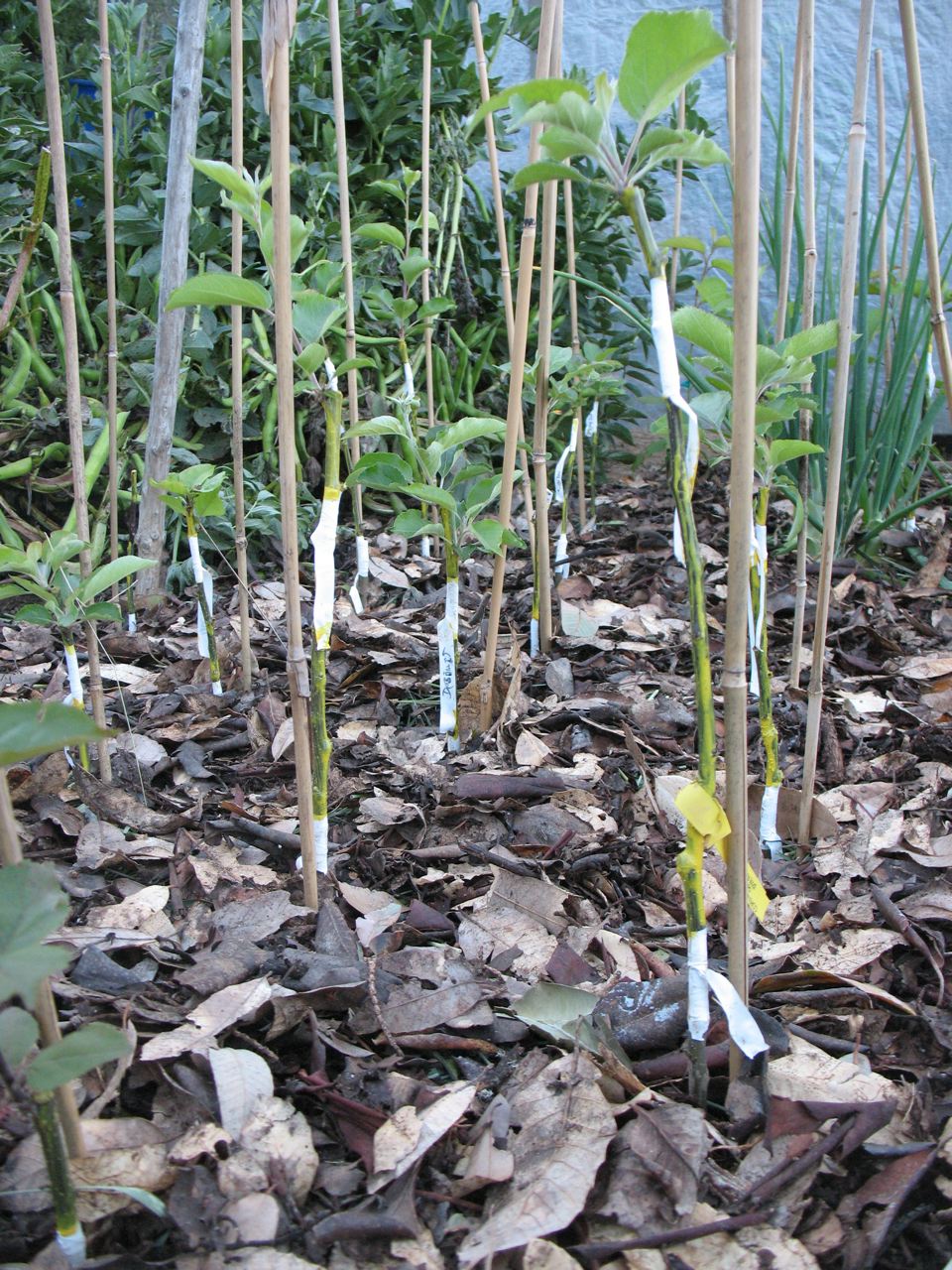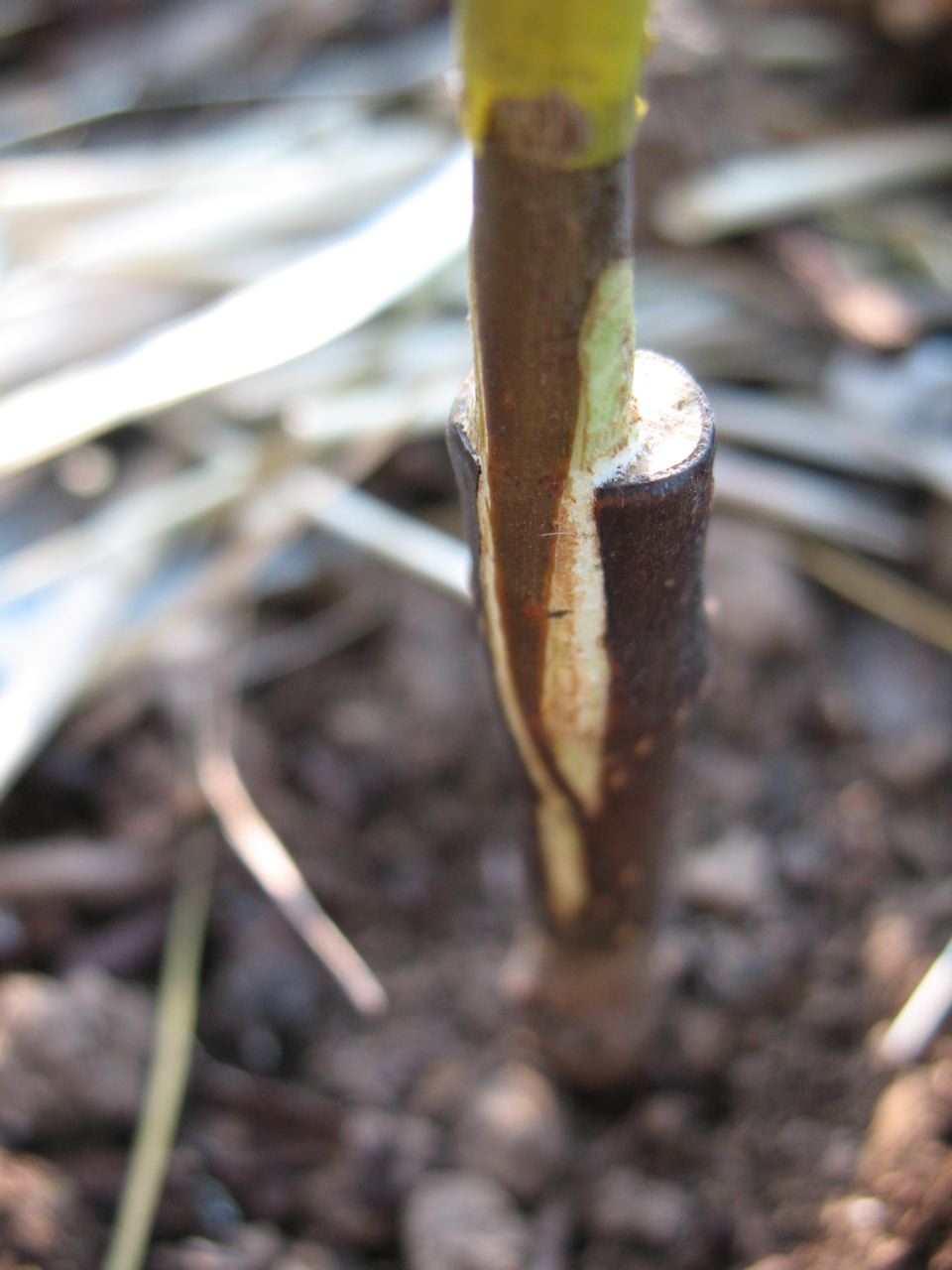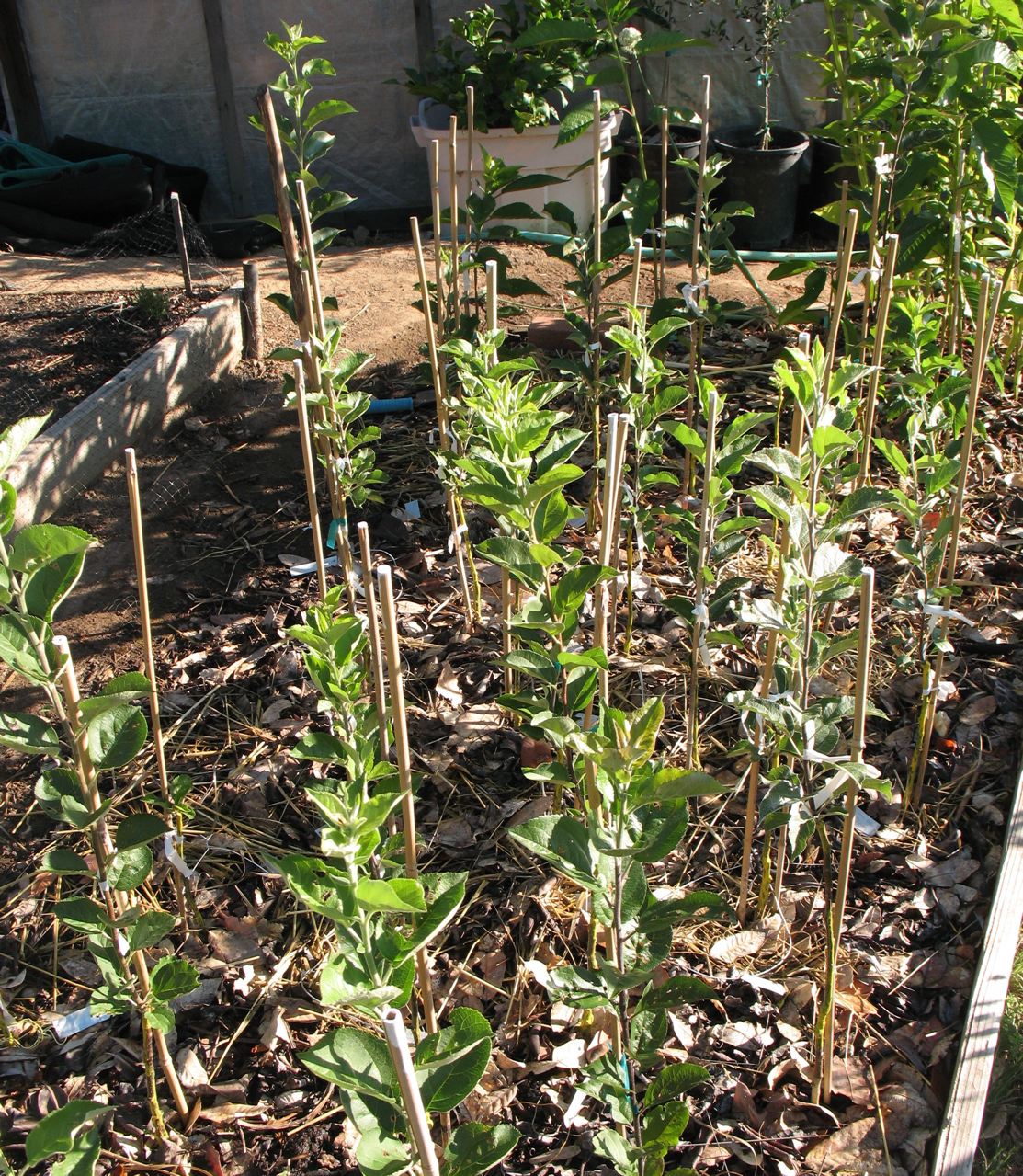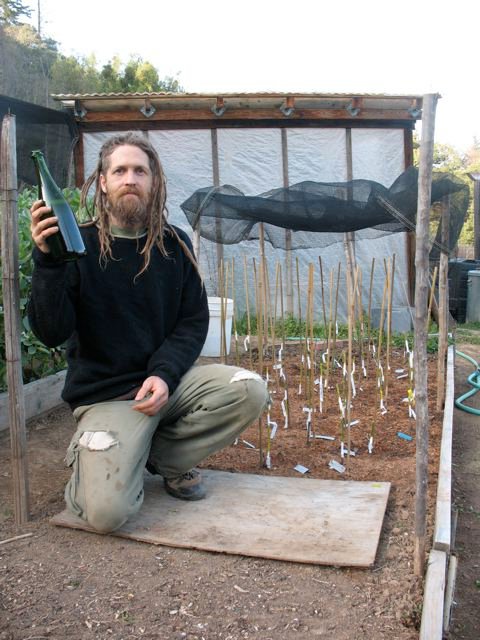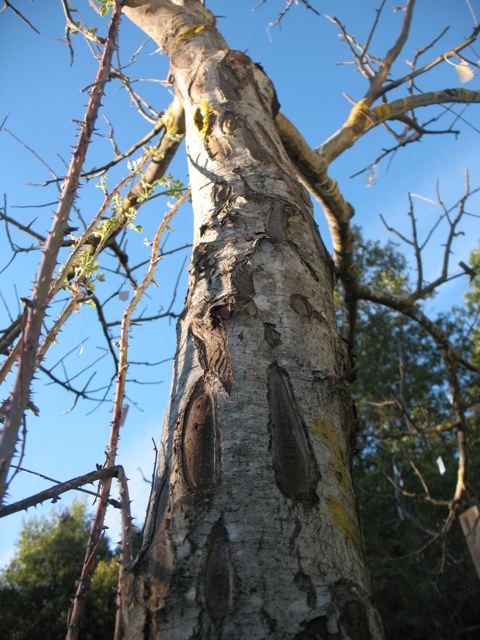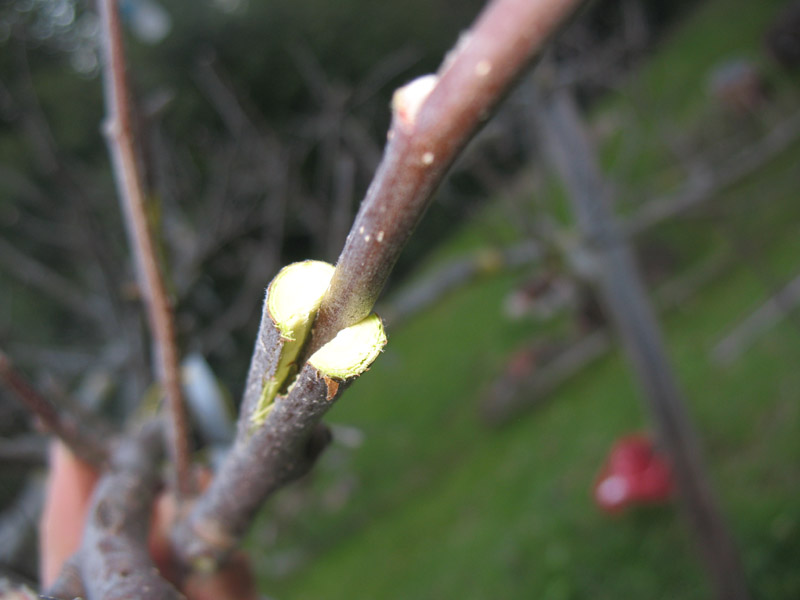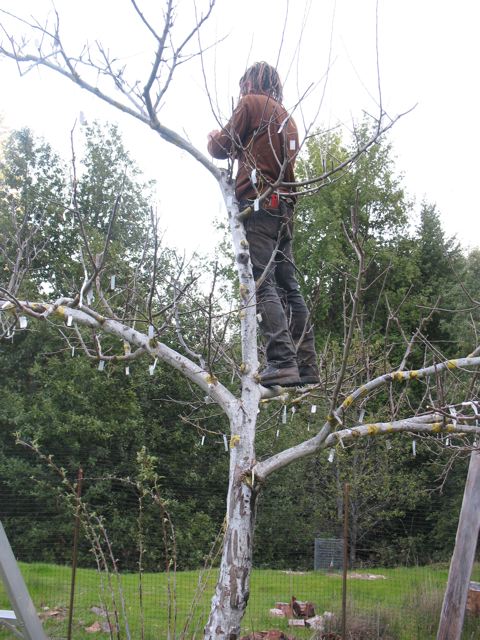In which I use the tricky manipulation of grafting 3 different apple varieties together to create trees that are small yet drought resistant
Inter-stem trees sprouting on in the nursery row. Note two bandages on each tree.
A long time ago fruit tree grafters selected certain rootstocks that would create smaller trees for small gardens and special purposes like espalier training. Dwarfing rootstocks are naturally small varieties of trees that confer their diminutive size to the fruit varieties grafted onto them. Early grafters had to make due with a limited selection of these dwarfing stocks, but these days there are ever smaller and more improved dwarfing rootstocks selected for size, rooting characteristics, disease resistance and ability to confer early fruiting to the variety grafted to them. Some of these modern stocks make trees of only a few feet in height. Last year I picked apples in a 30 year old orchard that had been grafted onto the dwarfing rootstock Malling 7. The trees were only about 7 to 8 feet tall making picking and maintenance very easy. These trees were also heavily loaded with fruit. One drawback to using dwarfing rootstocks is that they tend to be shorter lived than normal sized fruit trees. I'm planting trees for posterity and not just for myself, so I usually gravitate toward larger and healthier stocks. After observing these ease of handling with these small trees and noting that they seemed to be doing well after 30 years I figured maybe there was a place for some dwarfed apples here.
Dwarfed trees may tend to be shorter lived, but they bear at a younger age and can give higher yields per acre when planted at closer spacings. That's a nice advantage. I decided to put in a group of dwarfed trees grafted to varieties suitable for hard cider making. First I looked for a good dwarfing stock in the 9 to 12 foot high range and decided on the newer Geneva 30 rootstock. Alas, everyone seemed to be out of it because it was late in the season. Then I got onto the idea of using an inter-stem.
In inter-stem grafting (also known as double working and interstock) a normal sized vigorous rootstock is used for the roots of the plant, a second variety of dwarfing rootstock is grafted on top of that, and the fruit variety to be grown out is grafted on top of the dwarfing inter-stem. The result of this strategic placement of genetic materials is a fruit tree of the variety you want, dwarfed by an inter-stem but with a full sized root system to feed it.
The conditions in this area are essentially a wet-ish Mediterranean climate. We get plenty of rain each year, but it stops completely for the summer months at which time it can be very hot. Even when it rains in the summer, which is very uncommon, the quantity is never enough to really soak the ground enough to water a tree. Vigorous healthy drought resistant stocks are best under these conditions. For the bottom rootstock I chose m111 which is very slightly dwarfing but drought tolerant while also being resistant to heavily waterlogged soils and the pest wooly Aphis. It is a rootstock long tested by service and the one I have used almost exclusively here so far. For the inter-stem I used bud 9 which should make a tree averaging in the 8 to 12 foot range.
One of the drawbacks to grafting interstems is that two years are supposed to be required to grow an inter-stem tree, but that turns out to be untrue. First you are supposed to graft over the interstem onto the lower stock, and the next year you add the fruit variety you want on top of that. The apple is an easy fruit to graft and with the great success I've had grafting apples in general I decided it would be worth a try to graft all three pieces together the first year. I did a quick internet search was emboldened by finding that someone else reported doing just that very successfully... that discussion thread is here on the Home Orchard Society site.
One issue with grafting in general is that you are working with a stick that has no connection to the ground at all until the graft heals and therefore no way to replace any water that it uses up in trying to grow or loses to evaporation. After grafting this stick to the rootstock it slowly begins to form callus tissue which links up with the callus tissue from the healing rootstock to form routes for food and moisture to flow into the scion allowing it to grow on. The time between making the new graft and the healing and uniting of these tissues between stock and scion is a dangerous one for the scion. When grafting the interstems and the scions both at once there are two of these unions to heal before the scion receives nutrients and water. In light of these considerations I used a simple technique that I've been playing with for a few years to protect scions from moisture loss. That technique is simply to paint the scions, and in this case also the interstems, with grafting "wax" to slow the loss of moisture. I've used Doc Farwells grafting wax which is essentially a thick yellow paint that remains somewhat flexible. I try not to paint over the buds or, if so, then lightly. It seems to work. I used primarily whip and tongue grafts... a little on that here. Unless the scion and stock size were very different in which case I used cleft grafts. I prefer the whip and tongue generally as it is stronger and less liable to break if disturbed.
Out of 23 trees double grafted this year I lost only two, one of which died completely (preventable if I hadn't been pulling off all the suckers as they came out) and one on which the top died, but the bud 9 stem is sprouting and growing up again so I can re-graft it next year. Both probably failed due to poor scion wood, so if I would have had better scion wood, I think I would likely have gotten 100% take. They're generally growing well too except a couple that, again had really poor scion wood and are having a hard time getting off the ground.... and may not really. Still, totally acceptable, and improvable, results.
UPDATE FALL '10. The interstem trees in the nursery bed are considerable larger than the trees that are on just bud 9 roots. This would indicate, as I hoped, that the larger root system cancels out some of the dwarfing effect. That is fine with me since the bud 9 trees would probably be a little smaller than I wanted, and I was actually hoping this would be the case. I have not looked closely yet to see if there is a correlation between interstem length and dwarness, which some sources say there is.
I had to buy bud 9 rootstocks to get the interstems I needed, and after grafting the bud 9 interstems onto the m111 roots I grafted the left over bud 9 roots to some select dessert varieties and a few more cider varieties that I want to test out. I'm not sure exactly what I'm doing with the bud 9 trees yet, but I'll probably plant them only a couple feet apart in a long row and train them each to a single stem wired to a trellis and grown only a few feet high. This arrangement should give me a little laboratory of very early bearing trees to test out interesting varieties.
I saved a few inter-stem stocks for varieties, like Harrison, that I want to grow but was unable to acquire this year. Once I can test some of these varieties in my climate and see if they suit my cider making tastes, I can rework the trees to other varieties as needed, grafting on whichever ones I find most suitable, or even just testing other new types that I acquire through trading or scion exchanges. The new inter-stem trees should be ready for the ground this coming winter/spring.
Interstem tree varieties as of 7/10 (this list has greatly changed as of 3/13) King David 2 Wickson 2 Ashmead's Kernel 2 Muscat De Bernay 2 Dabbinet 3 Yarlington Mill 2 Marmora Gold 1 Harry Master's Jersey 2 Court Royal 1 Tale Sweet 2 Kingston Black 1 Stoke Red 1 Somerset Redstreak 1 Ellis' Bitter 1 Muscat De Dieppe 1
EDIT Feb 2013: These trees have done very well. The ones that I got into the ground and grew out right away are over head height and some bore fruit last year. They seem quite vigorous. A few were grafted over to other varieties which has delayed them. Many will provide a framework for grafting over to other varieties this year as I've changed my thinking on what I want out of them--- which is more dual purpose and dessert apples and less specifically cider apples. I may post a follow up at some point (WHICH I HAVE HERE). I have also done more interstem grafts and they have generally gone very well grafting all three parts at once. As an experiment, I did an interstem graft, and then stacked another 5 varieties on top of that just to see if they would take. Although some grew more than others (varietal dependent) all 6 grafts healed and grew!
https://youtu.be/mjcWqLP65HM?list=PL60FnyEY-eJDRcuY_h1U9QX4KurnShOay


